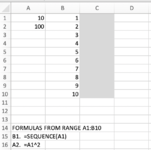Setting
Suppose I want to have the numbers from 1 to 10 generated in the range B1:B10. I can store N in A1 and type =SEQUENCE(A1) in B1. A dynamic array is generated that gets the job done.
My problem
I have an arbitrary computation in A2 that I want to copy 10 times in the range C1:C10. I want to be able to use dynamic arrays somehow, in such a way that: (a) I type some formula in C1, (b) this formula reads the "10" in A1, and the content of A2 is automatically copied in the range C1:C10. I want the solution to be so that, if I change A1 to, say, 20, the range where A2 is 'spilled' into is automatically adjusted to be C1:C20.
I do not want to use VBA to solve the problem.
I'm using Microsoft 365 (Excel 16.46.21021202) on a MacBook Pro (2019) running Catalina (10.15.7).
Any help would be greatly appreciated.
Suppose I want to have the numbers from 1 to 10 generated in the range B1:B10. I can store N in A1 and type =SEQUENCE(A1) in B1. A dynamic array is generated that gets the job done.
My problem
I have an arbitrary computation in A2 that I want to copy 10 times in the range C1:C10. I want to be able to use dynamic arrays somehow, in such a way that: (a) I type some formula in C1, (b) this formula reads the "10" in A1, and the content of A2 is automatically copied in the range C1:C10. I want the solution to be so that, if I change A1 to, say, 20, the range where A2 is 'spilled' into is automatically adjusted to be C1:C20.
I do not want to use VBA to solve the problem.
I'm using Microsoft 365 (Excel 16.46.21021202) on a MacBook Pro (2019) running Catalina (10.15.7).
Any help would be greatly appreciated.






